An Investor’s Guide to AgTech & Food Innovation
The following content is sponsored by Global X ETFs.

An Investor’s Guide to AgTech & Food Innovation
The global food system is under immense pressure due to three overarching trends:
- Population Growth
This naturally leads to an increasing demand for food. By 2060, the UN expects the global population to reach 10 billion people. - Limited Capacity of Existing Agriculture
Existing farming methods are very resource intensive and production has already been pushed to the brink. The UN predicts that by 2050, food production will need to increase by 70%. - Unsustainable Consumption
The world is consuming unsustainable amounts of food, particularly in terms of meat. While livestock accounts for 80% of agricultural land, it supplies just 18% of the global calorie supply.
As these trends collide, agriculture technology (AgTech) and food innovation are emerging as two possible solutions. This infographic from Global X ETFs will explain both.
The Major Themes of AgTech
AgTech is the use of technology to maximize crop yields while conserving water and land. Here is a quick explanation of its segments.
Precision Agriculture
Precision agriculture is the integration of artificial intelligence (AI) and the internet of things (IoT) into traditional farming practices. These technologies can provide farmers with more data, which in turn can be used to boost efficiency.
One example is the John Deere See & Spray machine, which uses various sensors to detect where weeds are. By only spraying weeds, farmers can reduce their herbicide use by up to 77%.
Robotics & Automation
Robotics & automation aims to reduce the amount of manual labor needed in agriculture. This multi-billion dollar market includes autonomous berry pickers, which demonstrate over 60% more productivity than humans.
Drones can also play a role, especially in regions where water is becoming scarce. For example, farmers in California are investing in drones that monitor fields for leaks and other issues. They claim this technology reduces their water inputs by over 40%.
Controlled Environment Agriculture (CEA)
CEA is the cultivation of plants in an indoor setting. This market is still in its infancy, but the ability to grow food almost anywhere, all year round, could transform the playing field for agriculture.
One of the most prominent CEA methods is hydroponics, where plants are cultivated in a nutrient-rich water-based solution instead of soil. Hydroponics could mitigate many of the world’s agricultural problems:
| Issue | Hydroponics Benefit |
|---|---|
| Food insecurity | A constant stream of nutrients means crops have 7 to 14 more growth cycles over traditional methods. |
| Water scarcity | Hydroponics systems make use of recirculated water, meaning plants grow with up to 90% less water. |
| Land degradation | Hydroponics systems can be stacked vertically, meaning farmers can grow 3 to 10 times more food in the same amount of space as traditional farms. |
Source: Princeton University
With pressures mounting on the global food system, innovative disruption will be needed to achieve long-term sustainability. AgTech solutions can certainly boost output, but what can be done on the consumption side?
Food Innovation
Food innovation refers to plant-based foods and other alternatives such as lab-grown meat. Given the immense scale (and carbon footprint) of the meat and dairy industry, these innovations could reap environmental benefits.
In terms of market share, alternative foods still have a long way to go. The following table lists global meat and dairy sales, by category, in 2020.
| Market | Traditional Option | Alternative Option | Alternative Share of Total |
|---|---|---|---|
| Meat | $1.4 Trillion | $6 Billion | 0.43% |
| Dairy | $574 Billion | $18 Billion | 3.14% |
Source: Global X ETFs
Considering that 80% of Americans have either purchased or are open to purchasing alternative meat products in the future, investors may view this sector as an attractive growth opportunity.
For further perspective, some analysts believe that by 2040, cultured meat (lab-grown meat) will account for 35% of the global market.
Introducing the Global X AgTech & Food Innovation ETF
The Global X AgTech & Food Innovation ETF (Ticker: KROP) seeks to provide investment results that correspond generally to the price and yield performance, before fees and expenses, of the Solactive AgTech & Food Innovation Index.
| Sector | Index Weight |
|---|---|
| Consumer Staples | 44.8% |
| Materials | 37.3% |
| Industrials | 11.6% |
| Health Care | 4.1% |
| Consumer Discretionary | 2.1% |
As of 01/31/2022
Investors can use this passively managed solution to gain exposure to innovation in the agriculture and food industries.
-

 Sponsored3 years ago
Sponsored3 years agoMore Than Precious: Silver’s Role in the New Energy Era (Part 3 of 3)
Long known as a precious metal, silver in solar and EV technologies will redefine its role and importance to a greener economy.
-

 Sponsored7 years ago
Sponsored7 years agoThe History and Evolution of the Video Games Market
Everything from Pong to the rise of mobile gaming and AR/VR. Learn about the $100 billion video games market in this giant infographic.
-

 Sponsored8 years ago
Sponsored8 years agoThe Extraordinary Raw Materials in an iPhone 6s
Over 700 million iPhones have now been sold, but the iPhone would not exist if it were not for the raw materials that make the technology...
-

 Sponsored8 years ago
Sponsored8 years agoThe Industrial Internet, and How It’s Revolutionizing Mining
The convergence of the global industrial sector with big data and the internet of things, or the Industrial Internet, will revolutionize how mining works.


